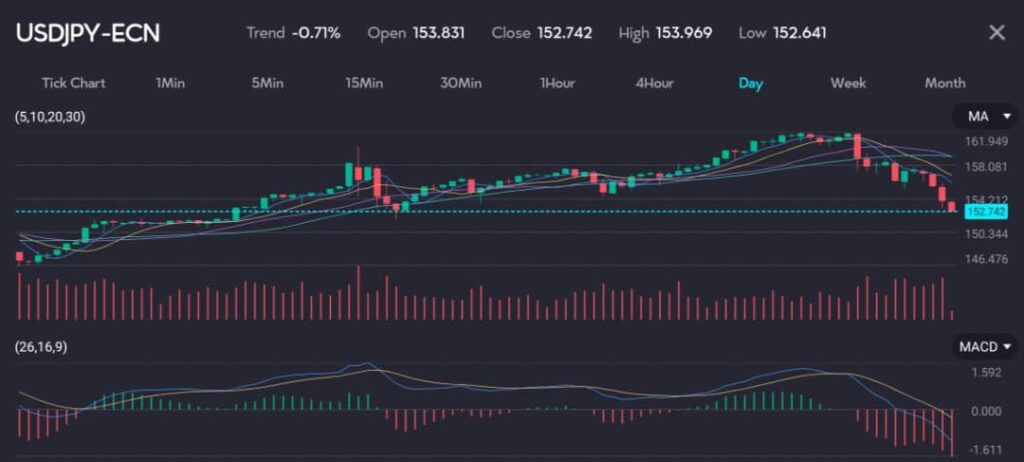Key points
- Yen rose over 0.5% to 152.835 per dollar, its highest in 2.5 months.
- Australian and New Zealand dollars fell on weak commodity prices.
- Euro and Sterling also struggled amid broader market risk aversion.
On Thursday, the yen experienced a rise, drawing support from the unwinding of carry trades ahead of the Bank of Japan’s (BOJ) policy meeting next week. This comes as a rotation out of megacap growth stocks dampened risk appetite broadly, providing safe haven bids for the Japanese currency.
Yen surges amid BOJ rate hike speculation
The yen increased by more than 0.5%, reaching an intraday high of 152.835 per dollar, its strongest position in 2.5 months. This movement is driven by traders abandoning short yen bets in anticipation of the BOJ’s July meeting, where a potential rate hike remains on the agenda.

See: Japanese yen on the rise as seen on the VT Markets app.
Reports indicate that the BOJ is likely to debate raising interest rates and unveiling a plan to halve bond purchases in the coming years, signaling its intent to unwind its substantial monetary stimulus. The threat of a taper of Japanese Government Bond (JGB) purchases and the rate hike is driving concerns in the dollar/yen and yen crosses markets.
Australian and New Zealand dollars hit by weak commodity prices
In other currencies, the Australian and New Zealand dollars continued to struggle due to weak commodity prices. The Australian dollar slid to $0.65575, its weakest level since early May, while the New Zealand dollar fell to $0.5915.
Both currencies are impacted by falling commodity prices, which have put downward pressure on their value.
Also read: Aussie and kiwi dollars struggle on China rate cuts; dollar drifts
The euro flopped following a dour purchasing managers’ index (PMI) reading, which showed growth in euro zone business activity stalling this month. This points to a gloomy outlook for the bloc. The euro eased 0.02% to $1.0837, further pressured by the weak PMI data. Meanwhile, sterling fell 0.09% to $1.2895, and the dollar index remained steady at 104.37.
Dollar gains safe haven support as Wall Street declines
The broader market saw the dollar gaining some safe haven support due to a bout of risk aversion after Wall Street ended sharply lower amid an ongoing rotation out of technology stocks.
Traders are closely watching the second-quarter U.S. growth figures due later in the day.
Japanese Finance Minister Shunichi Suzuki and top currency diplomat Masato Kanda both refrained from commenting on the yen’s recent sharp rise, leaving markets speculating about potential interventions.
The BOJ’s policy meeting could bring further volatility, especially if the central bank decides to take a more hawkish stance. Traders should prepare for possible shifts in currency dynamics, particularly in yen crosses, as the BOJ’s decisions could set the tone for the yen’s trajectory in the coming months.
Start trading now — click here to create your live VT Markets account.









